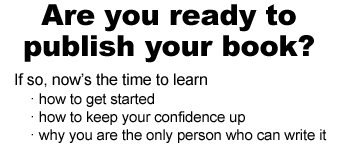 Just as each chapter in your book has a job to do, so does it have a structure, a framework upon which the content hangs.
Just as each chapter in your book has a job to do, so does it have a structure, a framework upon which the content hangs.
If your chapter heading is a question to be answered, the content of your chapter must provide the answer, preferably in a structure that is easy to follow. A consistent structure guides the reader through your book easily, enabling her to grasp your concepts and messages.
Throughout my book, Color Your LIfe Happy: Create the Success, Abundance and Inner Joy You Deserve, I decided on the following structure and order of chapter content:
1. Relevant quote
2. Attention-getter pulling the reader in the story
3. Reassure reader that he’s not alone
4. Example or story with action, dialogue or to show relationships
5. Advice or tip to bring about the change suggested in chapter title
6. Relevant comic relief to lighten mood
7. Summary of chapter
8. Activites to get reader to reflect and/or apply what was suggested in chapter
Here are excerpts from Chapter Two, Preparing Your Mind for Happiness, to demonstrate how the structure unfolds. Remember, in your mind change the chapter title into a question, How do you prepare your mind for happiness? The components of the chapter helps answer the question.
1. Relevant Quote
What you think of yourself is much more important than what others think of you.~Lucius Annaeus Seneca
2. Attention-getter pulling the reader in the story
If you’ve spent your entire life being moody, cranky, negative, judgmental, and just plain miserable, then you can’t expect to jump into happiness overnight. That would be a tremendous shock to your system—worse than being unprepared and diving into a pool of ice water. . .
3. Reassure reader that he’s not alone
For you, it’s probably scary to think about being happy—or to think it’s even attainable for you. After all, you’re comfortable and familiar with being unhappy. But if you’re going to become happy, then you’re going to have to step out of your comfort zone. Brrr!. . .
4. Example or story with action, dialogue, or to show relationships
Being happy is not for the faint-hearted. It takes courage and energy to move from one way of thinking to another or from one set of habits to another. And it seems that happiness can even worry other people.
For example, a member of my church stopped me one day and asked, “Are you always happy?”
“What do you mean?” I responded, feeling almost guilty for a moment.
“You’re always smiling,” he replied. . .
5. Advice, tips to bring about the change suggested in chapter title
You don’t need to make huge changes in your life in order to be happy, although positive changes will likely come about as a result. If you want to change your eating habits, for example, you could choose to eat half as much per meal, or just cut out one item. This small effort will get you started on your way without requiring a major overhaul.
Don’t be intimidated by others you think are happier than you. They may not be. Their happiness may be maintained with a lot of effort, just as a bodybuilder must maintain a certain lifestyle in order to keep up that chiseled appearance. . .
6. Relevant comic relief to lighten mood
Happiness Flashback I took lots of photos of my children to chronicle major and minor events in their lives. They were so used to posing for pictures in the midst of activities that no matter how upset or tearful they were, when I pulled out a camera, they froze in place and broke into smiles, and then returned to whatever dispute or turmoil they had been involved in at the time. 7. Summary of chapter
Happiness is not something you put on in the morning and remove at
night. It is a way of living. It’s the way you see the world and choose the
experiences you want to have.Four habits can help you create happiness in your life.
Conceive and visualize what you want, but be careful what you ask for.
Remember, words have power.
Set your goals without worrying about how you’ll get there.
Chop your big goal into small manageable ones. Think of small things
you can do today or tomorrow that will begin to move you toward your
goal.Instead of stepping out of your comfort zone, widen it to include new
habits and experiences. One of the easiest ways to do this is to associate
with others who are engaged in the activity that interests you.You must be willing to do whatever it takes to get where you want to
go. If you aren’t, then how do you expect to get there?Don’t let bad news stunt your growth. It’s all around us, but it can be
a dream killer if you dwell on it. Like all living things, the economy goes
in cycles. It will be down, followed by up, followed by down, and so on.Failure, though we try to avoid it, is part of life as well.
Though positive affirmations work for me, they don’t work for others.
Thinking brings about results to match it. What’s important is to find a
technique that brings about the results you desire.While you may have trouble accepting the concept of positive thinking,
consider other factors researchers agree also lead to happiness: adequate
sleep, a balanced diet and exercise.Finally, to make happiness a part of your daily life, you need to bring
your inner critic in line and enable your intuition to get louder. Be good
to yourself. Put your best interests first. Learn to say “no” to things that
pull you from your goals or deplete your positive energy.8. Activities to get reader to reflect and/or apply what was suggested in chapter
a. Make a list of all the activities, events and experiences you’ve really enjoyed. It doesn’t matter what they are. Only you know which things have made you feel good and given you joy—not only while you were doing them—but even just remembering them. They may even be things you haven’t done since childhood or your youth. . .
b. List one goal you’ve delayed or been afraid to pursue. It doesn’t matter
whether it’s a personal, spiritual or career goal. Only share your goal with people who are supportive. . .c. Do you know people who have accomplished the same goal as yours?
You don’t have to know them personally, just know where they are
located. If so, list their names here. . .
Sometimes your chapter structure will be clear to you at the very beginning. Other times it evolves as you create and/or edit your manuscript.
In either case, by having a structure throughout your book, your readers will be able to follow you easily from chapter to chapter until the end just as you planned. When this happens, they not only get the answer to the questions posed by the book title and chapters, but also now anticipate your next book.
Do you have a book idea under construction? I would love to be your partner in putting its structure in place.. If you are ready to begin, pop me an email right now with “READY” in the subject line at [email protected] . Be sure to include your phone number and I’ll call you within 24 hours.
I’m going over to check for your email right now.










